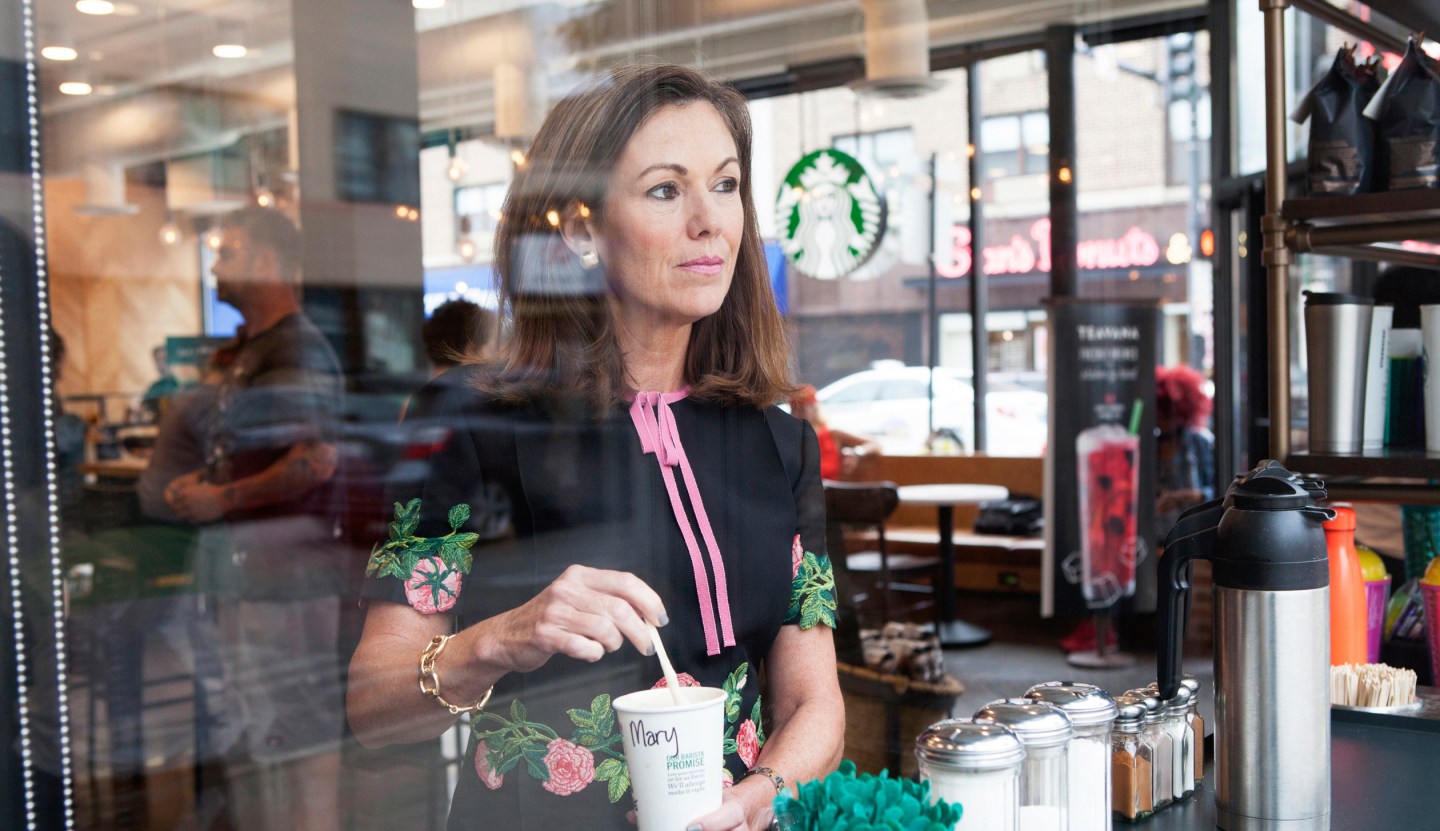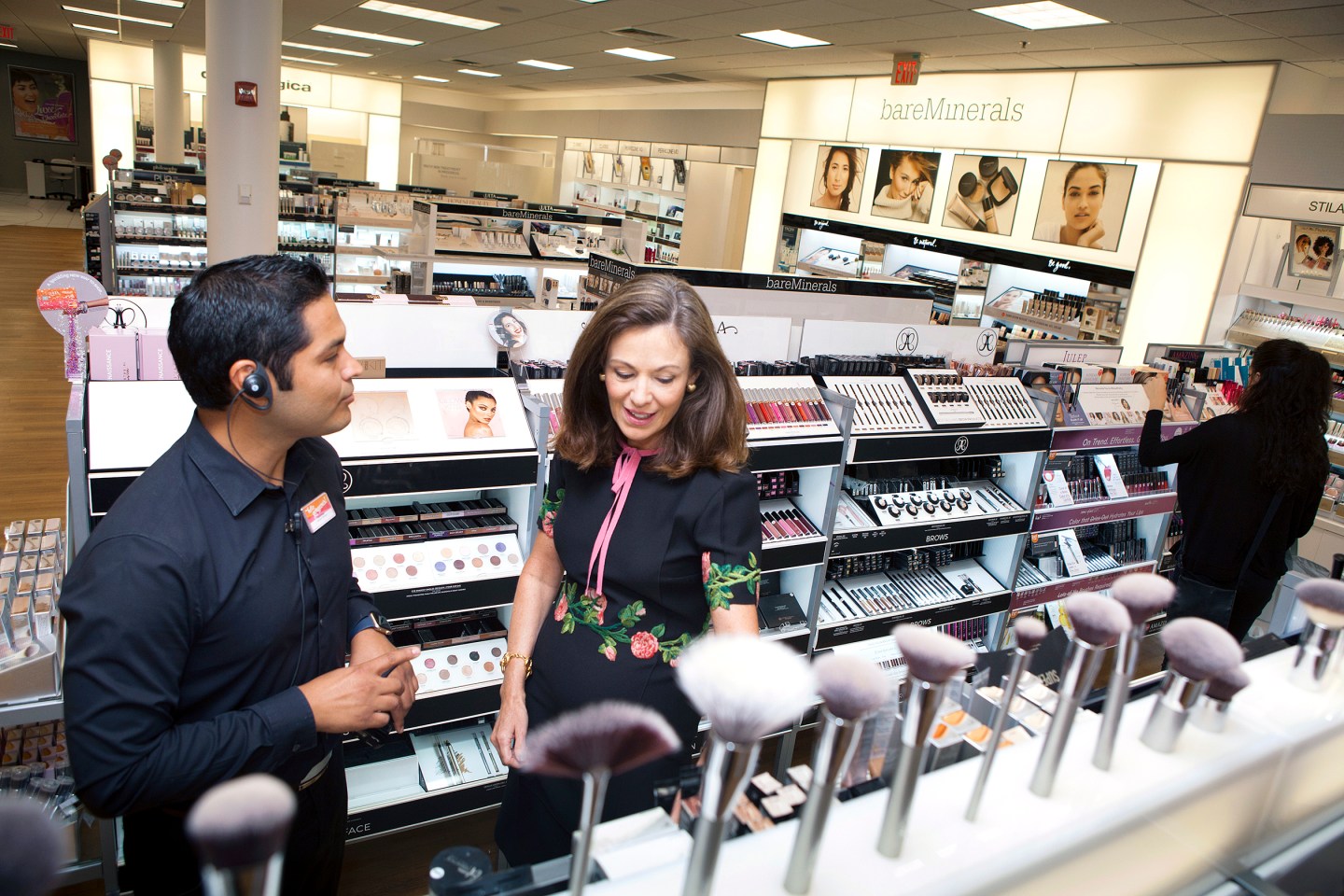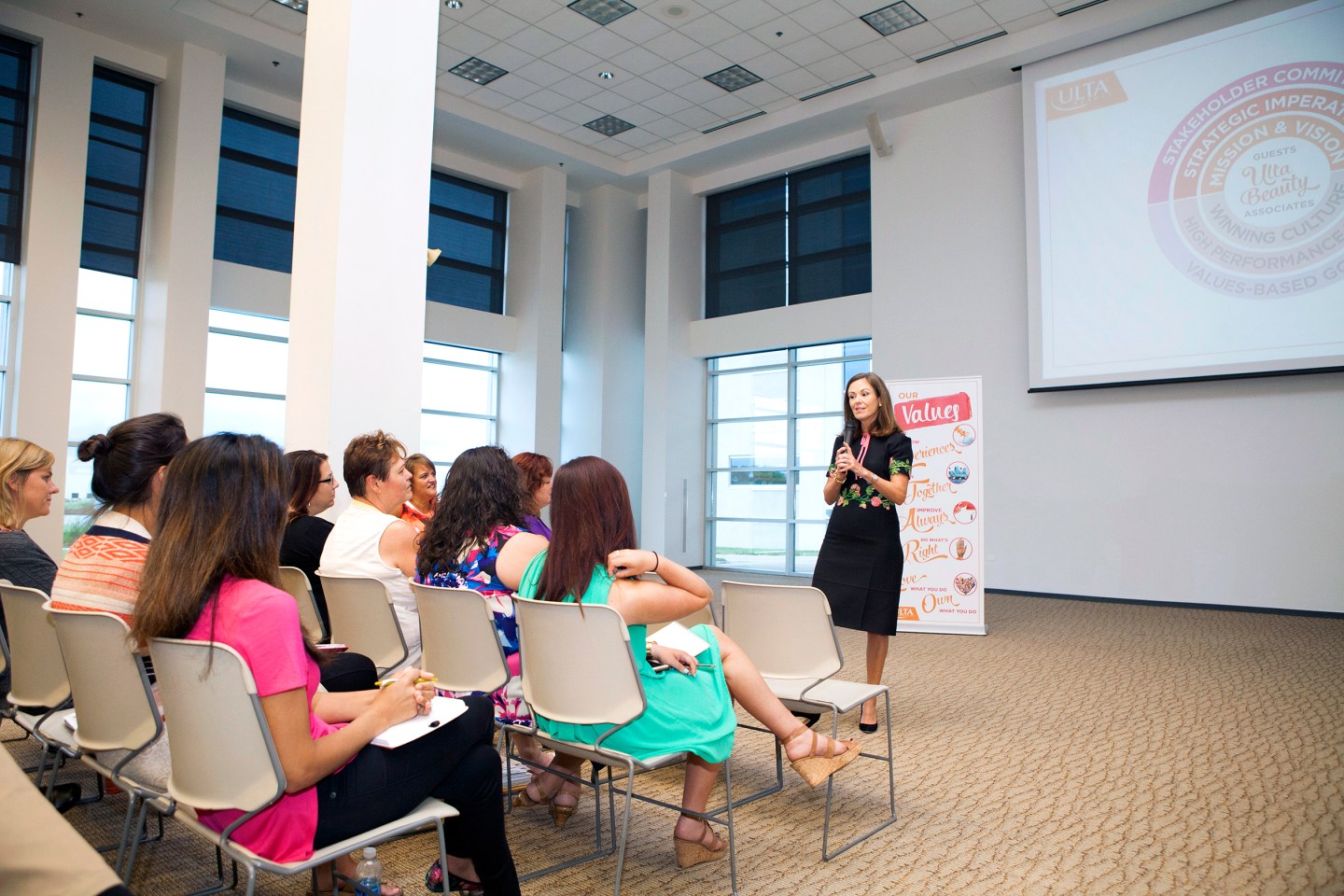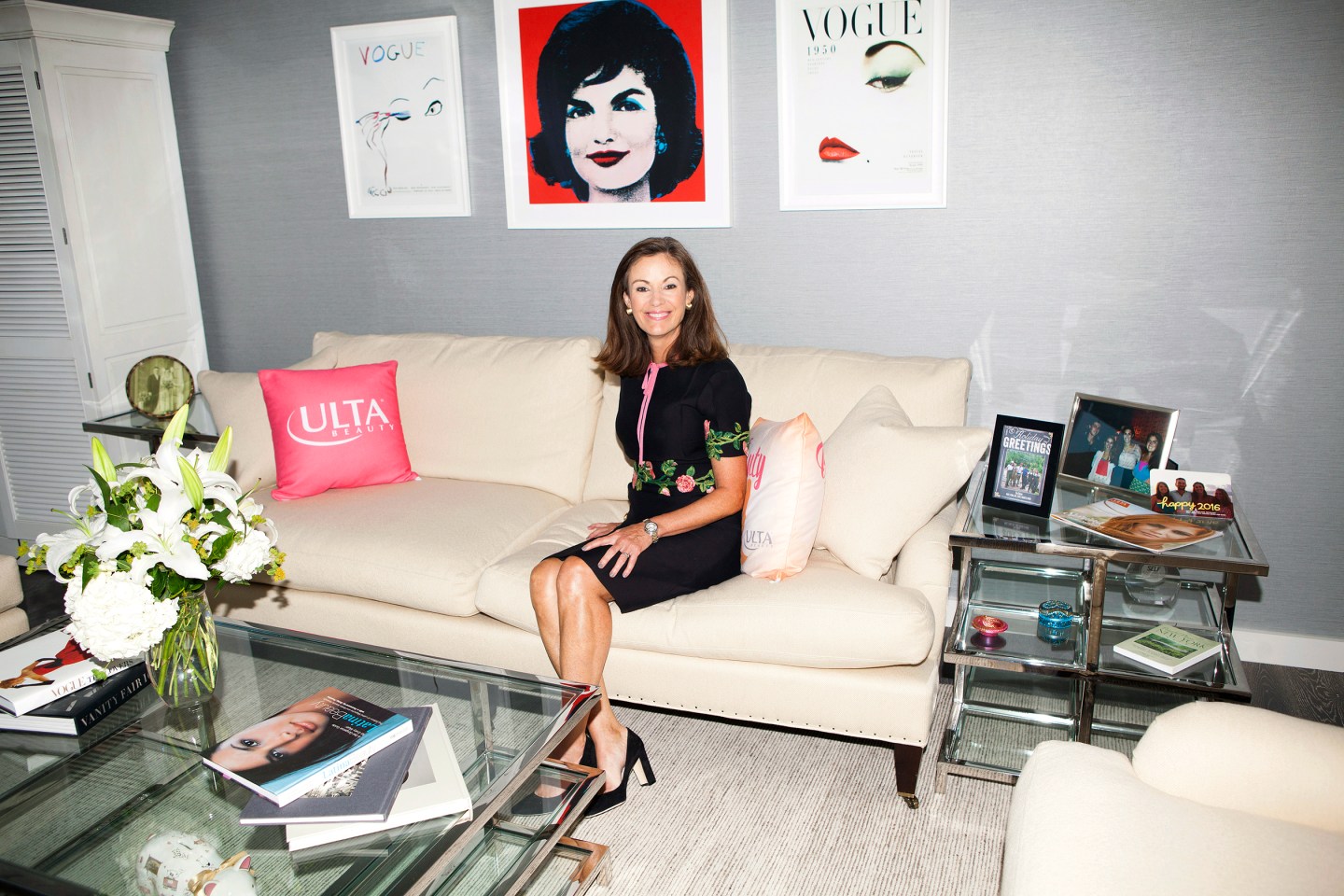How Ulta and Mary Dillon Are Winning the Beauty Battle

How Ulta and Mary Dillon Are Winning the Beauty Battle
Can the fast-growing cosmetics empire keep outmaneuvering the big drugstores and department stores? That’s up to CEO Dillon.
It didn’t take Mary Dillon long to realize she was in over her head.
Six months into her tenure as CEO of Ulta Beauty, Dillon wanted to see what it felt like to work on the retailer’s front lines on the craziest shopping day of the year. So on Christmas Eve in 2013, during a family ski holiday, she picked up a six-hour sales-floor shift at an Ulta store near Salt Lake City.
Inconspicuous in dress-code-compliant black shirt and pants and an Ulta name tag, Dillon found herself besieged with questions from customers—about this facial mask or that hair-coloring treatment—and overwhelmed by just how much she didn’t know about the 20,000 different products Ulta sells. Eventually, at the store manager’s suggestion, she took a spot at the front of the store. “The only thing I was qualified for was handing out shopping bags,” she recalls.
That’s what she was doing when she had an epiphany. Another customer came up with a stack of coupons and asked Dillon how to apply them, given their mazes of terms and conditions. Dillon couldn’t decipher the discounts either. But what really ignited her agita was what those coupons said about Ulta’s marketing—its focus on the constant discounting that she calls a “race to the bottom.”
 5:57 a.m. Mary Dillon commuting in suburban Chicago.Photograph by Rebecca Greenfield for Fortune
5:57 a.m. Mary Dillon commuting in suburban Chicago.Photograph by Rebecca Greenfield for Fortune
“It really hit me that day,” Dillon says. “I didn’t want Ulta to be thought of as the retailer for discounts. I wanted Ulta to be known as a beauty retailer.”
That may sound like a hair’s-breadth distinction to a layperson, but it’s a big deal to Dillon and Ulta Beauty (ULTA).
Ulta’s formula for selling beauty products—put them all under one roof and offer deals, deals, deals—turned the chain into a fast-growing juggernaut, a very rare success story in a gloomy decade for retail. Though it’s largely invisible in posh urban shopping districts, the Bolingbrook, Ill., company now ranks as the country’s biggest specialized beauty retailer. “They understand how American women buy beauty,” says Wendy Liebmann, CEO of WSL Strategic Retail.
Since 2008, Ulta’s store count has tripled—it recently opened its 900th location—and sales have followed suit, reaching $3.9 billion in 2015. Comparable sales growth, which strips out results from newly closed or opened stores, has also soared, rising an astonishing 14.4% year over year in Ulta’s most recent quarter, head and shoulders above even the best-performing chains (most of which would be thrilled to hit 2%). Investors have salivated over the results: Ulta’s stock is up more than 250% since Dillon became CEO, and its market capitalization now exceeds $15 billion, towering over retailers like Macy’s (M), Kohl’s (KSS), and Nordstrom (JWN), whose sales are several times greater.
But all that growth has brought Ulta to a critical juncture. Competition is getting hotter, as rivals from drugstores to department stores to specialty chains like Sephora chase the fast-growing spending of beauty-product buyers. Shareholders’ expectations are sky-high—maybe unsustainably so. And Ulta remains unknown to a large swath of America.

To keep winning in this arena, Ulta is striving to redefine itself—making its image more about customer experience and convenience, less about coupons. That challenge and many others fall to Dillon, a 55-year-old marketing veteran with an easygoing air—and a deep well of experience at huge brands ranging from Gatorade to McDonald’s (MCD). Howard Schultz, CEO of Starbucks (SBUX), whose board Dillon joined in January, says she has the kind of savvy that will help Ulta stand out in a crowded retail field: “She understands the theater and the romance.”
That savvy has helped Dillon keep the momentum going, despite her lack of a beauty background: The Ulta CEO job is her first in the industry since she was 16. “Ulta was not even on my radar” when she was approached about the gig in 2013, she tells Fortune at Ulta’s headquarters, 30 miles southwest of Chicago. But that, she adds, was a good thing: It gave her a clean slate. Any speculation Dillon might be a don’t-rock-the-boat leader was quashed in 2014, when she announced that Ulta planned to expand to 1,200 stores by 2019. En route to that goal, she has already rewritten much of Ulta’s playbook—the first steps in a transition she hopes will elevate the company from strip-mall secret to household name.
To see the full 2016 Most Powerful Women list, click here.
![]()
Ulta owes its success so far to an all-inclusive ethos. It sells everything from mass-market brands to high-end cosmetics to professional hair-care products, all in a format that lets customers try before they buy. Ulta offers salon services too, so in one trip you theoretically could get your hair done and get a facial, and then buy a curling iron and moisturizer to maintain the look at home.
 7:02 a.m. Dillon at a Starbucks in Naperville, Ill. She recently joined the company’s board.Photograph by Rebecca Greenfield for Fortune
7:02 a.m. Dillon at a Starbucks in Naperville, Ill. She recently joined the company’s board.Photograph by Rebecca Greenfield for Fortune
The chain was the brainchild of a group of former executives at Osco, a Midwestern regional drugstore, whose insight was that busy women didn’t want to go to a drugstore, then a mall, then a salon to shop for beauty products. The idea, recalls Terry Hanson, an Ulta cofounder, was “to save women time.” That may sound obvious today, but it wasn’t the norm in 1990, when Ulta opened its first five stores. Nor was it the founders’ only prescient idea: In 1994, Ulta introduced a shopper-rewards program, a relatively new concept in retail at the time. The program, now called Ultamate, is one of the nation’s biggest loyalty programs, with 20.6 million members—and members account for an astounding 80% of its sales.
Ulta opened most of its early locations in strip malls. That was initially a function of how little rent it could afford, but it sped up the chain’s expansion. The strip-mall locations became an even greater asset after the Great Recession, as traffic at conventional malls dropped off. Along the way, Ulta developed a reputation as an oasis for women where shopping is a kind of playtime for the suburban mom. (“It’s not a chore,” is how Dillon describes an Ulta break.) Stores are relatively roomy—typically 10,000 square feet, with about 10% of that taken up by salon stations—and Ulta says three-quarters of customers spend at least 15 minutes there per visit.
 10:41 a.m. Dillon checking inventory with manager Domingo Gonzalez III at an Ulta store in Naperville, Ill.Photograph by Rebecca Greenfield for Fortune
10:41 a.m. Dillon checking inventory with manager Domingo Gonzalez III at an Ulta store in Naperville, Ill.Photograph by Rebecca Greenfield for Fortune
Ulta went public in 2007 and kept expanding aggressively. But growth was almost too easy, company directors now say: Ulta was moving a lot of product but falling behind on e-commerce and its supply chain—and, above all, on taking the company’s image up a notch. When CEO Chuck Rubin departed in 2013 to lead arts-and-crafts retailer Michaels Stores, the board opted for a fresh start. “We knew how to open doors,” says Charles Philippin, Ulta’s nonexecutive chairman. “The next big task was to figure out how to make our customers more loyal and get our brand awareness up.”
Enter Mary Navins Dillon.
![]()
You could almost believe Dillon was predestined to lead Ulta. The fourth of six children of a Chicago steelworker and a homemaker, Dillon got her first paycheck from Jewel-Osco. At a store in Darien, Ill., as a 16-year-old in 1977, Dillon first worked in candy and tobacco before moving on to cosmetics. There she was full of suggestions for ways to improve product layout—but managers were uninterested in employee feedback, so she kept them to herself.
She paid her way through college with odd jobs, working as a bank teller, cleaning houses, and waitressing at a comfort-food joint called R.J. Grunts. In 1984, a year after graduating from the University of Illinois at Chicago with a degree in marketing, Dillon started an executive training program at Quaker Oats. Her $29,000 starting salary floored her father, who had taken many years to reach that level.
 1:17 p.m. Dillon meeting with her executive team.Photograph by Rebecca Greenfield for Fortune
1:17 p.m. Dillon meeting with her executive team.Photograph by Rebecca Greenfield for Fortune
Dillon became known for going to great lengths to get inside customers’ heads. “She uses her empathy to understand their hearts and what might motivate them,” says Margaret Stender, a colleague and mentor at Quaker Oats. After becoming head of marketing for pet-food brand Kibbles ’n Bits, Dillon, who didn’t own pets, started the Good Doggie Club—meeting regularly with dog parents so she could learn what they loved, hated, and needed. In 2000, when she took over Gatorade’s marketing, Dillon signed up to run the Chicago Marathon to better understand distance runners’ needs. It was her first, and so far only, 26.2-mile race, but Dillon stunned her jock coworkers with an overachieving finishing time. The next day at work, she recalls, “everyone was looking at the newspaper and was like, ‘You just qualified for the Boston Marathon.’ ”
For family reasons, Dillon wanted to keep her career rooted in Chicago. (She and her husband, Terry, have four grown children, and Terry, a biochemist, was a stay-at-home parent.) In 2005 she landed with one of the city’s biggest corporate names, becoming global chief marketing officer at McDonald’s. McDonald’s chairman emeritus Andy McKenna, a mentor and fixture of Chicago’s business community, says Dillon mixed data-driven rigor with creativity; among her innovations was a “Global Moms Panel” that helped her vet the fast-food chain’s campaigns. Because of McDonald’s structure, however, Dillon didn’t have responsibility over a profit-and-loss line, and she didn’t have the hands-on authority she craved. Today she describes the job as feeding her “a big dose of humility.” But McKenna recalls her having big ambitions, saying, “She wanted to be a CEO.”
 3:18 p.m. Dillon holding a Q&A with Ulta “beauty associates.”Photograph by Rebecca Greenfield for Fortune
3:18 p.m. Dillon holding a Q&A with Ulta “beauty associates.”Photograph by Rebecca Greenfield for Fortune
In any case, when U.S. Cellular, a wireless carrier based in Chicago, came knocking in 2010, Dillon jumped at the chance to lead a company. The stint was a tough one. Regional carriers in general were struggling, and in three years as CEO, Dillon was unable to move the company’s stock. She also made an early misstep: She decided the carrier wouldn’t offer Apple’s iPhone, saying it was too pricey. She reversed herself 18 months later amid falling customer counts. (Dillon calls her initial rejection “the right decision at the time.”) Still, the job gave Dillon even more executive expertise, including a better understanding of technology and experience running U.S. Cellular’s 400 retail stores—and it all added up to make her the leader that Ulta wanted.
Read More: Fortune Live: Fortune’s Most Powerful Women Special Edition
![]()
On a tour of a store in Naperville, Ill., Dillon is a warm whirlwind, hugging store managers and greeting stylists by name. She makes store visits around the country at least once a month, but her drop-ins are more frequent here, just a few miles from Ulta’s headquarters. Her visits often include mini focus groups with staff, during which Dillon asks for the brutally frank feedback she didn’t feel entitled to give as a teenage drugstore clerk.
Dillon’s own tastes in beauty products could be called Midwestern Put Together—stylish but not showy. (Last year on an Ulta trip, she bought a pair of Ardell false eyelashes—only to immediately remove them, satisfied that “I can do this if I need to.”) On store visits she adopts a customer’s mind-set: She’s in the market for a good red lipstick and considers herself a hair-product aficionado, boasting that she’s “great at braids” and does a mean updo. But she’s also quick to boast about improvements. Just inside the store sits a stack of catalogs for Ultamate members. These used to be glorified coupon-clipper books with dull fonts and drab design. Now it looks like something a shopper might actually want to read. “It’s not just price, but about product and teaching the customers about beauty,” Dillon says.
“[Dillon] understands the theater and the romance that are necessary in all aspects of the customer experience.”
Though the company was soaring when she became CEO on July 1, 2013, Dillon saw that there were cracks in Ulta’s mirror. Market research at the time showed a 75% overlap between Ulta’s offerings and Amazon’s beauty assortment. That meant Ulta was “Amazon-able” and needed to compete on much more than price. The board gave Dillon a mandate to elevate Ulta’s presentation, marketing, and product lines and generally catch up with the times on the e-commerce front.
Those catalogs represent just one tiny brushstroke in the makeover. Ulta’s in-house brands, which account for only about 3% of sales, are getting an upgrade. Dillon has overhauled the Ultamate loyalty program, introducing new perks like one that offers some items exclusively to members. The more Ultamate shoppers Ulta has, the better its analytics for deciding on new products and new store locations. And Ulta has just launched its first-ever store credit card—yet another way to gather better shopper data.
Dillon has also strengthened Ulta’s technical backbone. In 2014 she set a long-term goal for e-commerce to double from 5% of Ulta’s sales to 10%; since then, it has grown at a searing pace of about 50% a year. Dillon’s team has opened two new distribution centers to support e-commerce, along with a suite of IT systems to improve merchandising (the art of what to stock and when). To better understand the supply-and-delivery process, Dillon has been known to show up in jeans and tennis shoes to work on Ulta loading docks.
Few elements of Dillon’s strategy are as important as her efforts to ramp up Ulta’s higher-end beauty-product offerings. It’s easy to see why: Last year, sales of prestige beauty products rose 7%, according to NPD Group. Dillon and chief merchandising and marketing officer Dave Kimbell, with whom Dillon worked at U.S. Cellular, have introduced 200 new brands, including luxury lines like Estée Lauder, Clarins, and Jessica Alba’s Honest Beauty. Ulta is rolling out souped-up in-store boutiques for upmarket brands like Lancôme and Clinique at 500 of its stores.
 6:09 p.m. Dillon, shown here at Ulta’s headquarters in Bolingbrook, Ill., rose in the marketing world by getting inside her customers’ heads. She once ran a marathon just so she could better understand Gatorade drinkers’ needs.Photograph by Rebecca Greenfield for Fortune
6:09 p.m. Dillon, shown here at Ulta’s headquarters in Bolingbrook, Ill., rose in the marketing world by getting inside her customers’ heads. She once ran a marathon just so she could better understand Gatorade drinkers’ needs.Photograph by Rebecca Greenfield for Fortune
Brands like these used to shun Ulta because of its down-market locations. That began to change in the 2000s, and now, in a virtuous circle that Dillon wants to perpetuate, Ulta’s success is giving it more clout with developers in finding prime locations for new stores—helping her expand store count while gussying up the chain’s overall image. “Over time our real estate is getting better, not worse,” says Ulta’s chief financial officer, Scott Settersten. You’re likely to find older Ulta stores next to, say, a 99-cent store or a convenience store. But Ulta’s preferred neighbors are retailers like T.J. Maxx and Target—because of the middle-class shoppers they attract—and now some stores can be found next to a Trader Joe’s or Whole Foods (WFM).
Regardless of the store address, Ulta’s reliable growth has contrasted favorably with the ongoing department-store meltdowns, making it easier to lure luxury brands. “There is nothing wrong with strip malls if Ulta has a nice presentation, traffic, training, and experience,” says Fabrizio Freda, CEO of Estée Lauder. In other words: Down-market stigma be damned.
Read More: How Ulta outruns bigger retailers in the beauty-products race
![]()
Ulta is far from the only company that has noticed “the lipstick effect,” beauty’s status as a recession-proof revenue driver. According to Euromonitor International, the $80-billion-a-year U.S. beauty industry has been growing 4% a year since 2010—much faster than other areas of retail. Hispanic and African-American women make up a disproportionate share of the market, and featuring more diversity in Ulta’s marketing is among Dillon’s big goals.
Ulta commands about 3% of the beauty and salon market, and Dillon thinks she can double that. But Ulta will have to keep raising its game in a tough competitive field. Sephora, owned by French luxury giant LVMH, skews more urban and high-end, but 45% of Ulta customers also shop there, according to Kantar Retail. It’s keeping the heat on by testing high-tech features like iPad stations that offer beauty classes and virtual makeup try-ons. On the department-store front, J.C. Penney (JCP) is opening more Sephora locations within its stores and upgrading its in-house salons. Struggling Macy’s (M), meanwhile, is speeding up the expansion of its Bluemercury luxury-beauty chain.
 6:47 p.m. Dillon, a Chicagoland native, has spent all but four years of her career in the region. During college at the University of Illinois at Chicago, she waited tables at Lincoln Park comfort food eatery R.J. Grunts, which keeps a photo gallery of former staff; a photo of Dillon from 1980 sits just above and to the right of her head.Photograph by Rebecca Greenfield for Fortune
6:47 p.m. Dillon, a Chicagoland native, has spent all but four years of her career in the region. During college at the University of Illinois at Chicago, she waited tables at Lincoln Park comfort food eatery R.J. Grunts, which keeps a photo gallery of former staff; a photo of Dillon from 1980 sits just above and to the right of her head.Photograph by Rebecca Greenfield for Fortune
Drugstore chains and retail giants are also in the mix. Target (TGT) and Kohl’s have “beauty concierges” to help their customers. By year-end, CVS (CVS) will have upgraded the beauty areas at 4,000 stores, and Walgreens (WBA) will have deployed the full skin-care and cosmetics offerings of its higher-end Boots No. 7 line at 1,800 stores. “Drugstores are doing more in beauty than any other retail channel,” says Kantar Retail director Brian Owens. “They want to convert shoppers who may have gotten ideas at Sephora or Ulta,” stealing the patronage of customers looking to simply restock familiar brands.
For now, investment analysts seem to think Ulta can keep its edge. “The burden is on Ulta” to keep its product line fresh, says Oliver Chen, a retail analyst with Cowen & Co., but thanks to “the solid management team, the very good concept, and the scale, the momentum bodes well.”
How Ulta’s Growth Is Exceeding Sales Expectations:
Of course, no company’s momentum is infinite. Last year, Ulta’s stock rose 37%, and the board rewarded Dillon with a compensation package of $18.6 million. That made her the sixth-best-paid U.S. woman CEO in 2015, ahead of the likes of Mondelez International’s Irene Rosenfeld and HP’s Meg Whitman, according to the Associated Press. But numbers like that won’t be easy to replicate.
Dillon has begun readying Wall Street for a future in which Ulta posts comparable sales growth of 5% to 7% a year. That’s a figure that most retailers can only dream of attaining. Still, for Ulta, that will represent a slowdown, resulting from the law of big numbers, potential cannibalization from its new stores, and, yes, stiffer competition.
“We’re doing well,” Dillon tells staff during her Naperville store visit. “So now is the perfect time to ask, ‘What are we doing right?’ ” That’s not the only relevant question, however. Ulta has to fight the temptation to go into autopilot mode and coast on what works. “We are never complacent,” Dillon tells Fortune. “My job is to make us look 10 years out and be prepared.”
Read More: These 11 Powerful Women Are on Our Radar
A version of this article appears in the September 15, 2016 issue of Fortune with the headline “More Than Skin Deep.”
